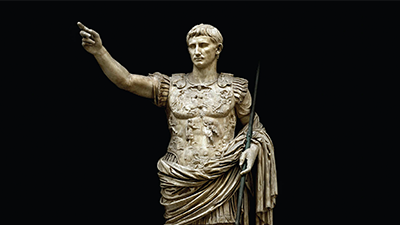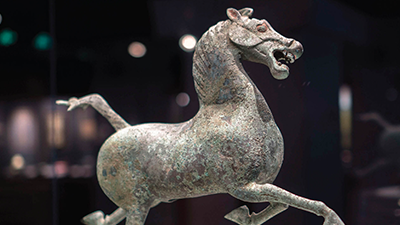Rome and Han China
Teacher Resources
Driving Question: How did Roman and Han Dynasty rulers grow and maintain their empires?
The Roman Empire and Han Dynasty China were the two pillars of the ancient world. These two empires linked with each other across a vast network of Silk Road trade. In the Mediterranean Sea and East Asia, they conquered vast territories and ruled over periods of peace and prosperity, thanks to innovative economic, political, and miliary strategies.
Learning Objectives:
- Analyze the formation and characteristics of the Roman Empire and Han Dynasty China.
- Learn about the historical thinking practice of continuity and change over time (CCOT).
- Use the historical thinking practice of sourcing to evaluate historical context and purpose.
Vocab Terms:
- dynasty
- eunuch
- mandate of heaven
- missionary
- patriarchal
- Pax Romana
- republic
Opener: Rome and Han China
To teach this lesson step, refer to page 2 of the Lesson 4.5 Teaching Guide.
Our Openers and Closers Guide provides more information about these short activities at the beginning and end of each lesson.
Luxury goods, such as silk, drove long-distance trade in the ancient world. This quick activity uses a primary source excerpt to help you understand the demand for silk.
Sources from Rome and Han China
Roman, Han, or Robot?
- Students conduct research for a primary source from either the Roman Empire or Han China, selecting a short (100-word) excerpt.
- Next, they work with AI to create a fake primary source from either Rome or Han China (whichever they do not have the real source for).
- Students then circulate their two sources, seeing who fools the most people into thinking their fake source is real.
- Debrief: Which AI-generated sources were most believable? What made them convincing? Were there any clues that the AI text was fake?
How this helps: Students need to develop historical empathy as they consider how a historical person would have thought and communicated while also considering how to evaluate sources for authenticity.
What can two ancient empires from very different parts of the world teach you? You’ll find out when sourcing documents from Roman emperor Augustus and Han government officials of Emperor Zhao.
-
Guiding Questions
-
Before you read
Preview the questions below, and then skim the article. Be sure to look at the section headings and any images.
While you read
Look for answers to these questions:
- What was the Pax Romana?
- How did Rome’s wars of conquest shape Roman society?
- How did the Roman approach to religion help them create an empire?
- What does silk tell us about women in Roman society?
- When did the Roman Empire fall?
After you read
Respond to this question: What do you think made Rome so successful at building, expanding, and ruling its empire?
-
Guiding Questions
-
Before you read
Preview the questions below, and then skim the article. Be sure to look at the section headings and any images.
While you read
Look for answers to these questions:
- What types of state and communal structure existed prior to the formation of the Han Dynasty in China?
- What types of philosophies did the Han rulers adopt and why was it an advantage to incorporate multiple philosophies instead of just one?
- What innovations in farming and trade developed during Han rule?
- Who were the Xiongnu and how did the Han attempt to deal with this group?
- What issues eventually led to the fall of the Han Dynasty?
After you read
Respond to this question: What factors do you think were most important in making the Han period a golden age for China?
Introducing CCOT
To teach this lesson step, refer to page 8 of the Lesson 4.5 Teaching Guide.
For a quick review of how OER Project addresses CCOT, take a look at the OER Project CCOT One-Pager.
How do we know where we are if we don’t know where we’ve been? Understanding continuity and change over time—CCOT—will help you know where we are, where we’ve been, and where we’re going.
Closer: Rome and Han China
To teach this lesson step, refer to page 10 of the Lesson 4.5 Teaching Guide.
What would you do if you were transported to the ancient world? Use your imagination as you choose an empire.
Beliefs in Ancient China
To teach this lesson step, refer to page 10 of the Lesson 4.5 Teaching Guide.
Continue learning the details about Han China through this video, which looks across China’s long dynastic history into Confucianism and the Mandate of Heaven.
-
Guiding Questions
-
Before you watch
Preview the questions below, and then review the transcript.
While you watch
Look for answers to these questions:
- What was the Mandate of Heaven?
- How does the Mandate of Heaven reinforce Confucian philosophy?
- Why were the Qin so important to Chinese history?
- Why might the brutality of the Qin have been exaggerated?
- Who was Confucius and what was his philosophy based upon?
After you watch
Respond to this question: What does it mean that the “Mandate of Heaven is a remarkably flexible explanation of historical causation”?





